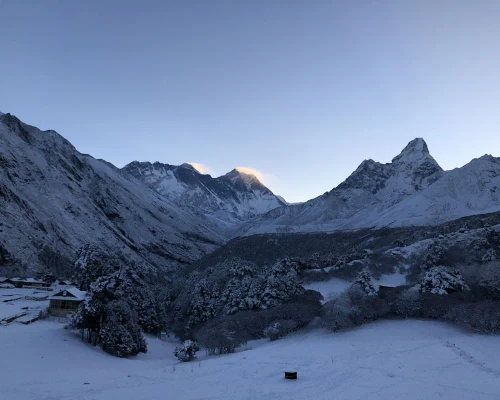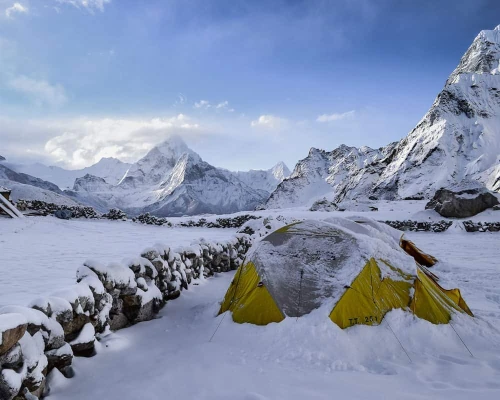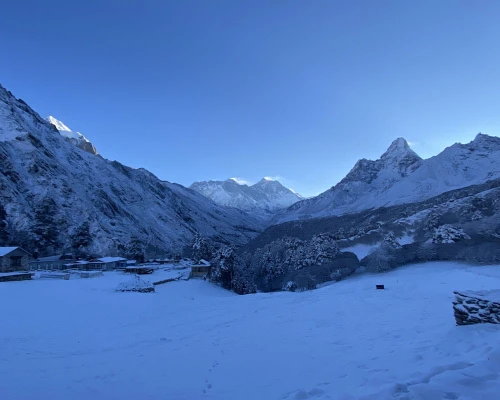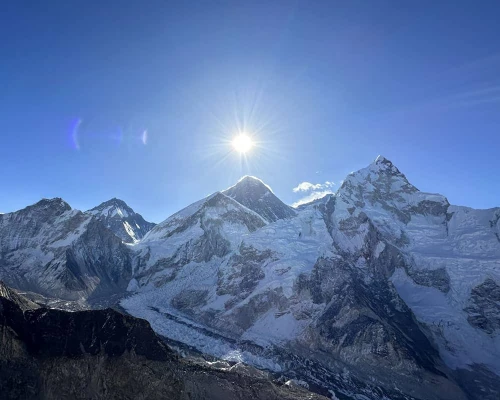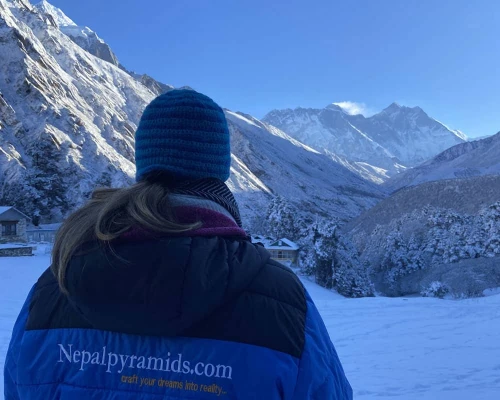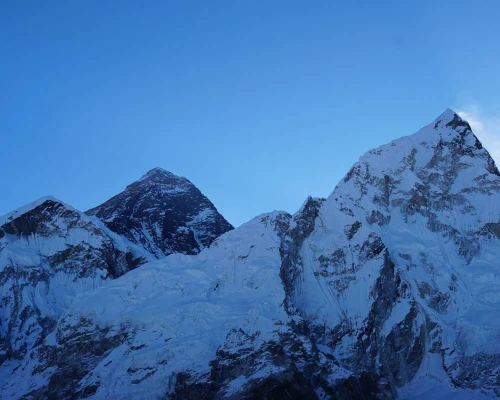December Everest Base Camp Trek Highlights
- Witness breathtaking, crystal-clear views of Everest and surrounding peaks.
- Experience the magic of less crowded peaceful trails and pristine winter landscapes.
- Enjoy cozy nights in authentic mountain tea houses with local hospitality.
- Witness the Milky Way that illuminates the winter landscape which is simply magical.
- Challenge yourself with an extreme high-altitude winter adventure.
- Get the entire Sherpa Villages for yourself and explore as if you own it which are usually overcrowded in the peak season.
- Capture stunning photographs of snow-capped Himalayan giants including Everest, iconic Ama Dablam, Lhotse, Nupse, Thamserku, and many others.
- Find your solitude in the profound silence and serenity of the mountains.
- Bond with fellow trekkers and locals over a warm chimney and hot drinks.
- Witness the raw beauty of nature in its most untouched winter state.
- Earn the bragging rights of conquering Everest Base Camp in winter.
Trek to Everest Base Camp in December - The Perfect Time to Go
Freezing temperatures and extreme dryness may prevent some adventurers from pursuing Everest Base Camp Trek in December. However, those who take up the challenge for an Everest Base Camp trek in December will be rewarded with one of the most dreamlike and serene experiences in the Himalayas. In December the winter conditions create an entirely different trekking environment, making prominent EBC look like a less-trodden untouched valley.
December provides you with serene paths and clear views under the bright blue heavens. Trekkers trekking during this month of the year can have a magical mounting view of the surrounding mighty peaks free from cloud obstructive clouds. Due to the extreme chill factor, there will not be many trekkers like in the peak season time, so you can enjoy great tranquility and solitude without any disturbances.
Securing accommodation on the way to Everest Base Camp is usually very competitive during the peak trekking seasons. In December you will enjoy worry-free access to ample accommodations. Tea houses that are typically overcrowded with trekkers in peak season sit mostly vacant during this winter's extreme chill.
December trekkers will have abundant room choices, discounted off-season rates, and exclusive access to amenities like hot showers, a hot chimney, and battery charging. With fewer guests to accommodate, the teahouses will provide enhanced hospitality and comfort. Despite December being peak winter and very cold, finding shelter any night keeps December adventurers at hearty ease.
The night sky view will be spectacular filled with glittering stars unhindered by artificial light. The chilling air and profound stillness fill a mystical atmosphere. Extra preparedness with gear is very important to combat the extreme cold during this time of year.
However, those who venture here in December relax in the magic of the Everest region to its most natural form. If you are seeking the most serene and solitary time to trek to EBC, a December Everest Base Camp Trek promises adventure, beauty, and the ultimate test of perseverance.
Why Everest Base Camp Trek in December is GREAT?
Everest Base Camp Trek in December certainly offers a unique adventure experience. Despite the trek being challenging due to extreme cold and being an off-season journey, the experience is magical. The month of December without a doubt delivers spectacular views, true solitude, and absolute serenity.
Here's why December is considered the perfect time to do EBC Trek:
- Crystal-Clear Skies: It is said that December delivers the clearest skies with unhindered views of the majestic mountain peaks and surrounding landscapes.
Spectacular Vistas:
- During the day: Delivers open deep blue sky with outstanding views without clouds.
- At night: A clear night sky with abundant glittering stars, one of the most incredible views one could imagine.
Opportunities:
- Peaceful Trails: You will experience the raw beauty of Sagarmatha National Park without the maddening crowd of trekkers. It’s indeed a beautiful experience to walk in the peaceful trails of the world’s most popular trekking destination.
- Exclusive Care: With only a few trekkers on the trail you will receive more personal attention from the teahouses and your guides. Since in the peak season, the high demand for service takes away this personal attention.
- Pristine Winter Paradise: With fewer people on the trail and less activity the winter landscapes offer a picturesque scenery that looks pristine. One would not imagine that this place could be so overcrowded in the peak season time.
- Great Photography Opportunities: Trekking in December offers you a great opportunity to capture the Himalayas in their winter glory.
Experience Solitude:
- Witness the deep silence of the mountains with serenity. Experience mindfulness.
- Connect deeply with nature, wilderness, and your surroundings
- Witness the most beautiful night sky, the beauty of which can’t be compared with anything else.
For those prepared for extreme cold, December offers the true magnificence of the Everest region. As the beauty and silence unfold before you, the bitter cold fades away. Since not many people trek to EBC during winter you will discover solitude and peace of mind.
Are you ready to challenge yourself and discover the winter magic of Everest Base Camp?
Also, check WHY TREK TO EVEREST BASE CAMP and Everest Base Camp Trek all year around.




